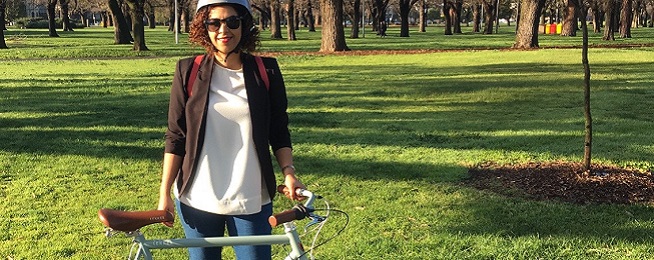Written by Leyla Asadi, General Manager Behaviour Change, Bicycle Network
I ride a bicycle quite often. It’s accessible, cheap and contributes to a healthy lifestyle. Thing is, I’ll never be seen doing it in knicks and Lycra jersey even though I spend my working days encouraging people onto bikes.
The images that usually accompany media stories are of people in specialist gear with bikes so light you could lift them with one finger. But if a bicycle doesn’t have regular pedals, you won’t see me getting on it.
I don’t know the “cycling terminology” for lots of bike parts and frankly I don’t care. What I do care about is finding ways to normalise riding a bike and I don’t think Strava and Spandex will do it; especially for the people who aren’t in it for the fitness alone.
We’re not athletes, we’re people going about our daily business on a bicycle.
There’s also the other end of the unhelpful spectrum, which is loading yourself up with so many things, you forget why you were heading out in the first place.
We’re often told you’ll need a list of items the length of your arm before you actually get on a bike, not to mention the expectation that we should be able to fix and maintain the bike ourselves (we don’t expect the same of car ownership).
This onus of unnecessary expectations is not helping to make bike riding a social norm and it shows. Women make up less than a quarter of all bike riders in Australia* and we need to do something about that.
We know if we build separated bike lanes more people will be inclined to ride but despite the safety aspect, there are still plenty of opportunities to get more women riding such as getting to work, dropping the kids at school or meeting friends for coffee.
So how do we do this when most of the representation of bike riding is middle aged white men in Lycra?
Now I’m not saying that people shouldn’t wear Lycra or shorts and t-shirts when riding because for many commutes and parts of the country it’s the most sensible option. And if the bike is your substitute for the gym, then that makes sense. But for those out there who could be convinced to ride a bike more, it’s a change in perception that we need, not a change of clothes.
Every time I ride either my three-speed or more regularly my eBike, I’m aware of my potential influence.
To me, the most effective way to bring others along on the journey is by dressing for my destination, not for my mode of transport.
People are always surprised to hear I’ve arrived somewhere via bicycle and comment “you don’t look like you’ve been riding a bike”. What they’re really saying is that my appearance is no different to anyone else. Ironically, looking like you’ve not been on a bicycle may be the best way to entice someone else to start riding.
If we want to get more people riding, we need to make the entry points simple.
When I stop at traffic lights near a tram stop, I notice other women looking at my bike and at me. You can almost hear what they’re thinking; “she looks like me and that bicycle actually looks comfy”.
They can see themselves reflected in my choices and I like to think that at best I may have planted a seed of interest and at worst, I have normalised riding a bicycle as a means of transport with no compromises or special clothing needed.
So, this Women’s Health Week, let’s shift the focus towards just getting our feet on the pedals rather than worrying if we’ve got the ‘right’ clothes on our backs.
Bicycle Network is a proud community partner of Jean Hailes Women's Health Week (7-11 September).
See what activities we've got planned and get involved with our riding challenge or photo competition to win some bike-friendly prizes. Click here to learn more
There are still too many women who don't take the time out to look after their physical and mental health. My advice; forget about the excuses, the makeup, the worry and #justride @bicycle_network pic.twitter.com/XDBXwiui7c
— Lolba (@lolba) September 8, 2020
Become our friend
Find out more about Bicycle Network and support us in making it easier for people to ride bikes.



